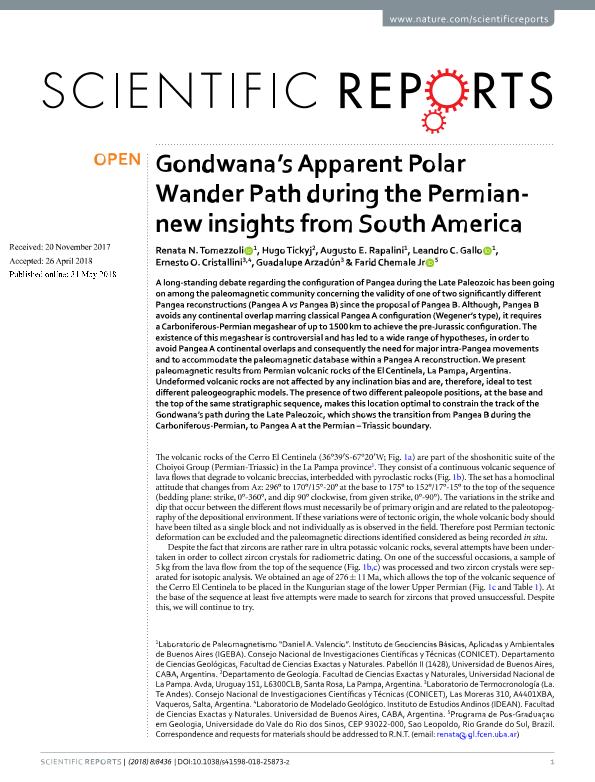Artículo
Gondwana's Apparent Polar Wander Path during the Permian-new insights from South America
Tomezzoli, Renata Nela ; Tickyj, Hugo
; Tickyj, Hugo ; Rapalini, Augusto Ernesto
; Rapalini, Augusto Ernesto ; Gallo, Leandro César
; Gallo, Leandro César ; Cristallini, Ernesto Osvaldo
; Cristallini, Ernesto Osvaldo ; Arzadún, Guadalupe
; Arzadún, Guadalupe ; Chemale, Farid
; Chemale, Farid
 ; Tickyj, Hugo
; Tickyj, Hugo ; Rapalini, Augusto Ernesto
; Rapalini, Augusto Ernesto ; Gallo, Leandro César
; Gallo, Leandro César ; Cristallini, Ernesto Osvaldo
; Cristallini, Ernesto Osvaldo ; Arzadún, Guadalupe
; Arzadún, Guadalupe ; Chemale, Farid
; Chemale, Farid
Fecha de publicación:
12/2018
Editorial:
Nature Publishing Group
Revista:
Scientific Reports
ISSN:
2045-2322
Idioma:
Inglés
Tipo de recurso:
Artículo publicado
Clasificación temática:
Resumen
A long-standing debate regarding the configuration of Pangea during the Late Paleozoic has been going on among the paleomagnetic community concerning the validity of one of two significantly different Pangea reconstructions (Pangea A vs Pangea B) since the proposal of Pangea B. Although, Pangea B avoids any continental overlap marring classical Pangea A configuration (Wegener's type), it requires a Carboniferous-Permian megashear of up to 1500 km to achieve the pre-Jurassic configuration. The existence of this megashear is controversial and has led to a wide range of hypotheses, in order to avoid Pangea A continental overlaps and consequently the need for major intra-Pangea movements and to accommodate the paleomagnetic database within a Pangea A reconstruction. We present paleomagnetic results from Permian volcanic rocks of the El Centinela, La Pampa, Argentina. Undeformed volcanic rocks are not affected by any inclination bias and are, therefore, ideal to test different paleogeographic models. The presence of two different paleopole positions, at the base and the top of the same stratigraphic sequence, makes this location optimal to constrain the track of the Gondwana's path during the Late Paleozoic, which shows the transition from Pangea B during the Carboniferous-Permian, to Pangea A at the Permian - Triassic boundary.
Palabras clave:
Gondwana
,
Permian
,
Paleomagnetism
,
Tectonics
Archivos asociados
Licencia
Identificadores
Colecciones
Articulos(SEDE CENTRAL)
Articulos de SEDE CENTRAL
Articulos de SEDE CENTRAL
Citación
Tomezzoli, Renata Nela; Tickyj, Hugo; Rapalini, Augusto Ernesto; Gallo, Leandro César; Cristallini, Ernesto Osvaldo; et al.; Gondwana's Apparent Polar Wander Path during the Permian-new insights from South America; Nature Publishing Group; Scientific Reports; 8; 1; 12-2018; 1-7
Compartir
Altmétricas



